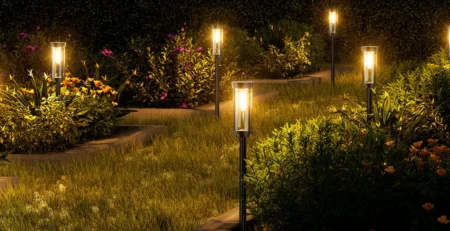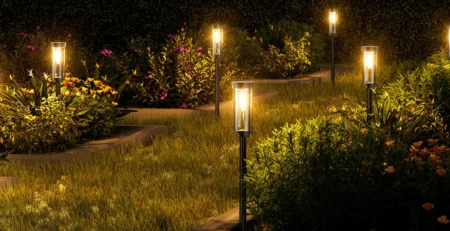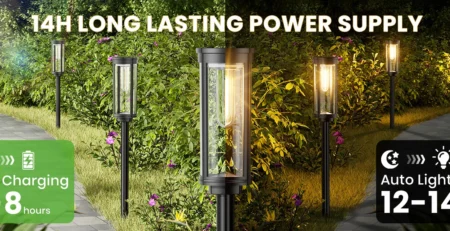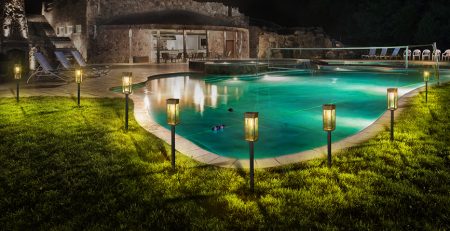Are solar path lights any good
Illuminating your outdoor spaces can transform your property, enhancing both its aesthetic appeal and functionality. Among the myriad lighting options available, solar path lights have emerged as a popular choice for homeowners and businesses alike. But are they truly worth the investment? Let’s delve into the world of solar path lights and understand their benefits, limitations, and overall value.
The Radiant Advantages of Solar Path Lights
Solar path lights have garnered significant attention in recent years, and for good reason. These illuminating harness the power of the sun to provide a sustainable and cost-effective lighting solution for outdoor spaces. By converting sunlight into electricity during the day and storing it in rechargeable batteries, solar path lights can illuminate your walkways, driveways, and garden paths throughout the night without relying on traditional power sources.
One of the most compelling advantages of solar path lights is their eco-friendly nature. Unlike conventional lighting systems that depend on electricity from the grid, solar-powered lights have a minimal carbon footprint. They operate using clean, renewable energy, making them an excellent choice for environmentally conscious individuals seeking to reduce their energy consumption and minimize their impact on the planet.
-6-1024x400.jpg)
Installation of solar path lights is remarkably straightforward, often requiring no wiring or complex setup procedures. This simplicity not only saves time but also eliminates the need for professional installation services, potentially reducing overall costs. The absence of electrical wiring also means there’s no risk of accidental electrocution or the need to dig trenches across your lawn to bury cables.
Maintenance of solar path lights is typically minimal. With no bulbs to replace and no electrical components to service, these lights often require little more than occasional cleaning to keep them functioning optimally. This low-maintenance aspect makes them an attractive option for busy homeowners or those who prefer a “set it and forget it” approach to outdoor lighting.
The best solar path lights consumer reports show that from a financial perspective, solar path lights can lead to significant long-term savings. While the initial investment might be higher compared to traditional wired lights, the absence of electricity bills and minimal maintenance costs can result in substantial savings over time. This makes solar path lights an economically savvy choice for those looking to illuminate their outdoor spaces without incurring ongoing expenses.
Illuminating the Potential Drawbacks
While solar path lights offer numerous benefits, it’s essential to consider potential limitations to make an informed decision. One of the primary concerns is their dependence on sunlight. In areas with limited sun exposure or during extended periods of cloudy weather, solar path lights may not receive sufficient charge to provide consistent illumination throughout the night. This can be particularly problematic in regions with long, dark winters or in heavily shaded areas.
The intensity and duration of illumination provided by solar path lights can vary depending on the quality of the solar panels, battery capacity, and overall design. Some cheaper models may not provide adequate brightness or may only last for a few hours after sunset. It’s crucial to research and invest in high-quality solar path lights to ensure satisfactory performance.
Durability is another factor to consider. While many solar path lights are designed to withstand outdoor conditions, exposure to harsh weather elements can potentially impact their longevity. Extreme temperatures, heavy rainfall, or snow accumulation may affect the performance and lifespan of these lights. Opting for weather-resistant models and providing proper care can help mitigate these concerns.
The aesthetic appeal of solar path lights can be subjective. While many appreciate their modern and sleek designs, some may find that certain models don’t complement their landscaping or architectural style. It’s important to carefully consider the visual impact of solar path lights on your overall outdoor design scheme before making a purchase.
Another potential drawback is the limited customization options compared to wired lighting systems. Solar path lights typically operate on a fixed schedule, turning on at dusk and off at dawn. This automatic operation, while convenient, may not suit those who desire more control over their outdoor lighting schedule or want to integrate their lights with smart home systems.
Maximizing the Potential of Solar Path Lights
To fully leverage the benefits of solar path lights and mitigate potential drawbacks, consider the following strategies:
- Strategic Placement: Position your solar path lights in areas that receive ample sunlight during the day. Avoid placing them in heavily shaded spots or areas where they might be obstructed by growing vegetation. Proper placement ensures optimal charging and performance.
- Quality Matters: Invest in high-quality solar path lights from reputable manufacturers. Look for models with efficient solar panels, durable construction, and weather-resistant features. While they may cost more initially, quality lights often provide better performance and longevity, offering better value in the long run.
- Combine with Other Lighting Solutions: Consider using solar path lights in conjunction with other outdoor lighting options. This hybrid approach can provide a more comprehensive lighting solution, especially in areas where solar lights might not perform optimally due to limited sunlight exposure.
- Regular Maintenance: Although solar path lights require minimal upkeep, regular cleaning can significantly improve their performance. Wipe the solar panels periodically to remove dust, dirt, or debris that might hinder their ability to absorb sunlight efficiently.
- Seasonal Adjustments: Be prepared to make seasonal adjustments to your solar path lights. During winter months or periods of reduced daylight, you may need to reposition the lights or adjust their angles to maximize sun exposure.
- Backup Options: For critical areas that require consistent lighting, consider having a backup power source or alternative lighting solution. This can ensure continuous illumination even during extended periods of unfavorable weather conditions.
- Aesthetic Integration: Choose solar path lights that complement your outdoor décor and landscaping. Many manufacturers offer a variety of styles, from modern to traditional, allowing you to find options that enhance your property’s overall aesthetic appeal.
Conclusion
In conclusion, solar path lights can be an excellent choice for many homeowners and businesses looking to illuminate their outdoor spaces efficiently and sustainably. While they do have some limitations, the advantages of eco-friendliness, cost-effectiveness, and easy installation make them a compelling option. By carefully considering your specific needs, environmental conditions, and aesthetic preferences, you can determine whether solar path lights are the right choice for your property.
If you’re interested in exploring high-quality solar lighting solutions, including solar path lights and other innovative outdoor lighting options, we invite you to contact us at info@forigat.com. Our team at BITPOTT is committed to providing top-notch solar products that combine efficiency, durability, and aesthetic appeal.
References
- U.S. Department of Energy. (2021). Outdoor Solar Lighting. Energy.gov. https://www.energy.gov/energysaver/outdoor-solar-lighting
- National Renewable Energy Laboratory. (2022). Solar Radiation Basics. NREL.gov. https://www.nrel.gov/research/re-solar.html
- American Lighting Association. (2023). Outdoor Lighting Guide. Lighting.org. https://www.lightingassociation.com/outdoor-lighting/
- Environmental Protection Agency. (2022). Energy Star Certified Light Fixtures. EnergyStar.gov. https://www.energystar.gov/products/lighting_fans/light_fixtures











Leave a Reply